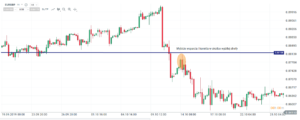Trading on withdrawal and playing corrections. Part of 1.
Learning how to play undo can be a great skill for a trader. Corrections on the market happen all the time, if the investor knows how to use them in trading, you can diversify your repertoire and find many more scenarios with high probability. Corrections can come in many different forms. We will focus on explaining the most common ones. We will also present techniques that can be used to play the proverbial rewind.
How do you define undo?
The most important rule - the price never moves in a straight line. Individual instruments on financial markets can usually be described as price waves. Markets alternately move in bullish (bullish) and bearish (bearish) waves. During an uptrend, the main waves of the trend go up. Corrective waves, on the other hand, are movements opposite to the direction of the current trend. When trading retraces, traders look for those waves and then the time to enter the trade. If you are a trader who typically plays a correction, you want to wait for the price to "pull back" during the trend to get a better entry price. When the market moves up and you expect the movement to continue, you want to trade at the lowest possible price. Withdrawals help find such opportunities.
Be sure to read: Irregular correction - "trap" for traders
Undo after breaking
Corrections after breaking are considered to be one of the more common ones and most traders have probably encountered them. They usually occur at turning points in the market when quotations from consolidation take place. With such plays, you should also always be careful about moving the stop loss to break even (popularly breakeven). Very often the price can catch our order if we move it too quickly and then go in the assumed direction. This can be seen in the example shown. The price moved in an upward trend, followed by a dynamic break in support. Many traders use such levels to adjust the timing of entry into position after breaking. However, they often make a mistake because they transfer their stop loss to breakeven too quickly. When the rollback occurs, they are thrown out of the transaction just to see the price turn in the expected direction, but without them "on board".
Another important question is: How do you trade backwards? In general, two main approaches can be assumed.
The first is the so-called aggressive approach. The aggressive trader waits for the price to return to the reversing zone and immediately enter the transaction. This technique has several assumptions:
- you can enter at the best possible price because this point often means the extreme point of the correction wave and retraction phase,
- the potential profit-risk ratio with this approach is often the highest because stop loss can be placed tightly,
- the disadvantage is certainly that the transaction is concluded in the opposite direction to the quotation movement, and the price can easily go much further against you,
- this approach may have a lower profitability ratio. However, it can be balanced by a higher R: R ratio.
Read also: Determining the direction of the trend - Victor Sperandeo method
The second approach is all the more conservative. The conservative trader waits for the price to continue the trend and break a new hole. Entry occurs as soon as a new, lower hole is reached. Thanks to this approach, we move according to the momentum. It also has to it that the moment of entering the position takes place later, so the R: R ratio is also smaller.
Both techniques work well in the markets. There is no better or worse, it all depends on the individual style of trade. These principles can also be applied to all other examples that will be presented. In the next article we will discuss horizontal corrections / retractions based on averages, trend lines and fibo levels.






















![Forex Club – Tax 9 – Settle tax on a foreign broker [Download the Application] Forex Club - Tax 9](https://forexclub.pl/wp-content/uploads/2024/02/Forex-Club-Podatek-9-184x120.jpg?v=1709046278)
![Trading View platform – solutions tailored to the needs of traders [Review] trading view review](https://forexclub.pl/wp-content/uploads/2024/03/trading-view-recenzja-184x120.jpg?v=1709558918)
![How to connect your FP Markets account to the Trading View platform [Guide] fp markets trading view](https://forexclub.pl/wp-content/uploads/2024/02/fp-markets-trading-view-184x120.jpg?v=1708677291)
![How to invest in ChatGPT and AI? Stocks and ETFs [Guide] how to invest in chatgpt and artificial intelligence](https://forexclub.pl/wp-content/uploads/2023/02/jak-inwestowac-w-chatgpt-i-sztuczna-inteligencje-184x120.jpg?v=1676364263)


![WeWork – the anatomy of the collapse of a company valued at $47 billion [WeWork, part II] wework bankruptcy story](https://forexclub.pl/wp-content/uploads/2024/04/wework-bankructwo-historia-184x120.jpg?v=1711729561)
![Adam Neumann – the man who screwed up Softbank [WeWork, part AND] adam neumann wework](https://forexclub.pl/wp-content/uploads/2024/04/adam-neumann-wework-184x120.jpg?v=1711728724)





![How to transfer shares to another brokerage office [Procedure description] how to transfer shares to another brokerage house](https://forexclub.pl/wp-content/uploads/2024/03/jak-przeniesc-akcje-do-innego-biura-maklerskiego-184x120.jpg?v=1709556924)

![The most common mistakes of a beginner trader - Mr Yogi [VIDEO] Scalping - The most common mistakes of a beginner trader - VIDEO](https://forexclub.pl/wp-content/uploads/2024/03/Scalping-Najczestsze-bledy-poczatkujacego-tradera-VIDEO-184x120.jpg?v=1711601376)
![Learning patience: No position is also a position - Mr Yogi [VIDEO] Scalping - Learning patience - No position is also a position - VIDEO](https://forexclub.pl/wp-content/uploads/2024/03/Scalping-Nauka-cierpliwosci-Brak-pozycji-to-tez-pozycja-VIDEO-184x120.jpg?v=1710999249)
![When to exit a position and how to minimize losses - Mr Yogi [VIDEO] Scalping - When to exit a position and how to minimize losses - VIDEO](https://forexclub.pl/wp-content/uploads/2024/03/Scalping-Kiedy-wyjsc-z-pozycji-i-jak-minimalizowac-straty-VIDEO-184x120.jpg?v=1710336731)






![Building a risk management plan - How to do it? [Guide] risk management](https://forexclub.pl/wp-content/uploads/2021/12/zarzadzanie-ryzykiem-300x200.jpg?v=1639495023)
![Automatic Stop Loss on MetaTrader 5 - how to do it? [Video] auto-stop-loss-mt](https://forexclub.pl/wp-content/uploads/2021/11/auto-stop-loss-mt-300x200.jpg?v=1637831541)











